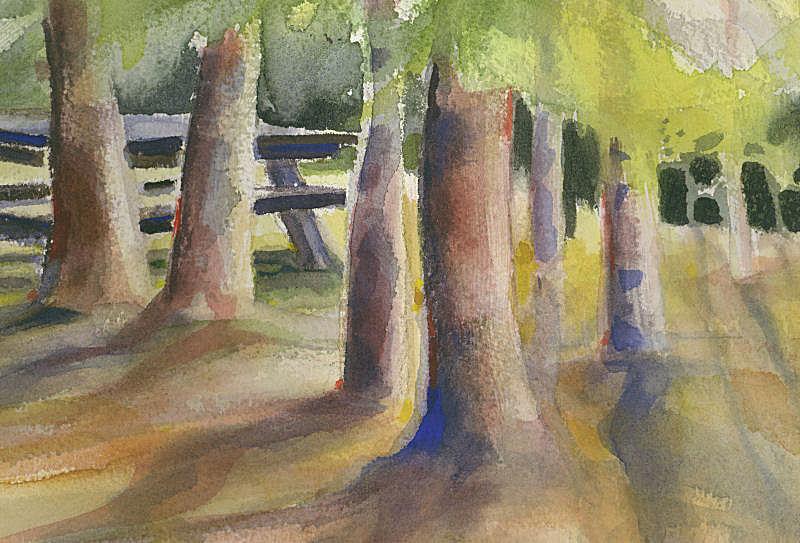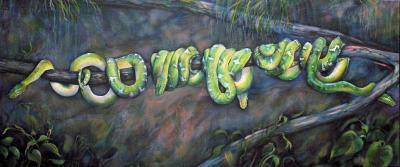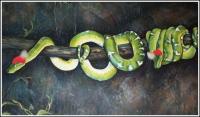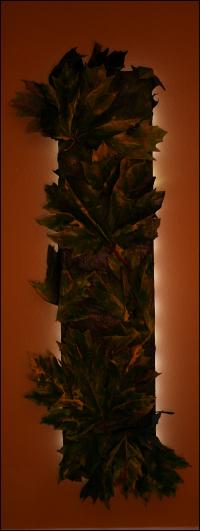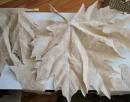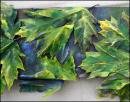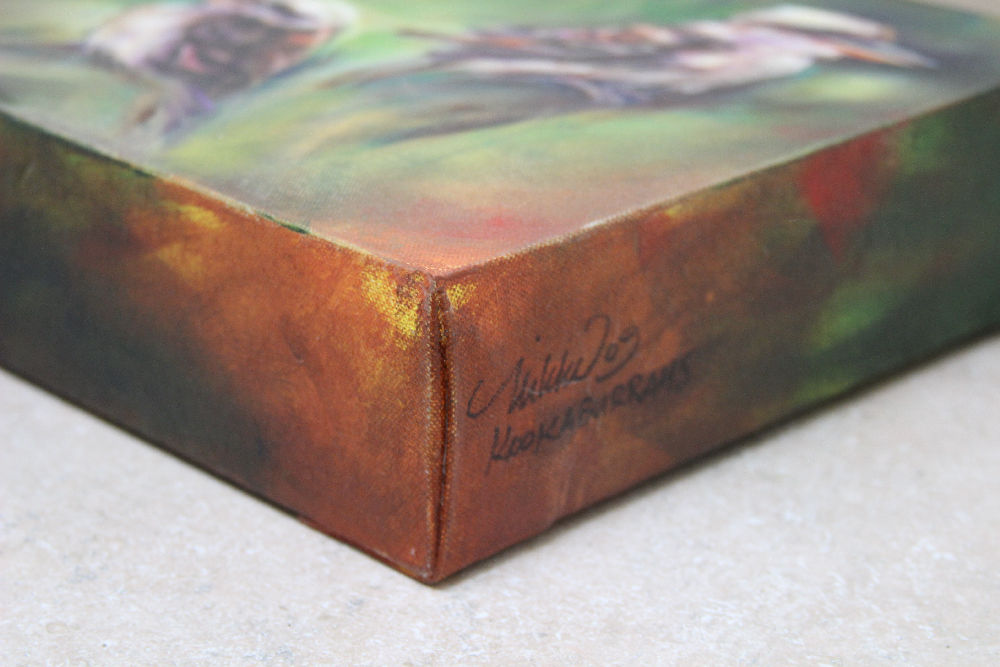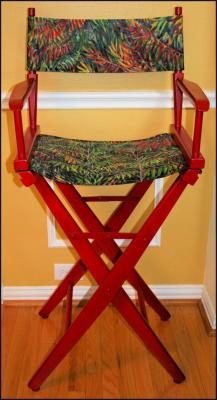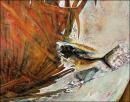trees
« Previous Entries Next Entries »The Campsite
Wednesday, October 21st, 2009
Thumbnails: 1) Value sketch using Payne’s Gray 2) Oct 21st in progress 3) finished, left detail. This is the 2nd week of the watercolor course offered by Jo Williams.
The Campsite, Maine, USA – 15 x 22 inches Watercolors on 140 lb. acid free cold press premium paper, 22H x 28W” professionally framed, dark cherry wood with brass title plate.
The Sound of Silence
Thursday, October 15th, 2009

The Sound of Silence, 36H x 24W x 2D inches acrylics on canvas, wrapped sides painted, narrow frame – finished today. After a second application of mask medium only on the snowflakes this time, some unbleached titanium and yellow ochre brought color back to the trunks. Snowflake mask was then removed.
Oct 13th, above: Phase 01 and 02
Oct 14th, Phase 03 and 04: Mask medium removal, then highlighting snowflakes.
500X Gallery: Landscape
Tuesday, October 6th, 2009
Saint Catherine’s Sunset, Ontario, Canada – 11H x 11W x 3D acrylics on canvas, wrapped sides painted, showingOctober 1 0 – 31st, 2009 500X Gallery Open Show: Landscape, 500 Exposition Ave. Dallas, TX. Opening Reception Saturday, October 10th, 7:00 p.m. – 10:00 p.m.
Oxide Gallery 1st Year Anniversary celebration today, Tuesday October 6th, 6:00 p.m. – 9:00 p.m. Happy Anniversary Oxide Gallery!
I’ll be giving a demo on the use of Masking Fluid in acrylics paintings, so come and reveal one painting by helping to peel off the rubberized mask – I don’t even know what it looks like underneath, so it will be a surprise for all of us. Techniques on applying the fluid will be demonstrated on another painting already in progress. Three pieces accepted in the current show at Oxide Gallery are:
Perpetual painting
Monday, October 5th, 2009
Like music
where silence between the notes sets the rhythm,
not painting is half the work.
 For all artists, the most mysterious question of all might be “is it finished?” , but for the sake of clarity and the examples here I’ll just refer to painters. One popular opinion is that the best painting is one that’s finished quickly; one that retains the artist’s first fresh impressions, otherwise it should be painted over or tossed in the garbage and a new one started immediately. There are solid reasons for not lingering too long on a painting, but in matters of the Art I’m always suspicious when I hear the word should being used in a sentence containing advice. Some art rumors are accepted as absolute when they could stand some explanation. It can be confusing enough for the experienced, but especially for beginners looking for ground rules and a map to follow.
For all artists, the most mysterious question of all might be “is it finished?” , but for the sake of clarity and the examples here I’ll just refer to painters. One popular opinion is that the best painting is one that’s finished quickly; one that retains the artist’s first fresh impressions, otherwise it should be painted over or tossed in the garbage and a new one started immediately. There are solid reasons for not lingering too long on a painting, but in matters of the Art I’m always suspicious when I hear the word should being used in a sentence containing advice. Some art rumors are accepted as absolute when they could stand some explanation. It can be confusing enough for the experienced, but especially for beginners looking for ground rules and a map to follow.
In Art though, for every should there is another option. The same suggestions don’t work for everyone. Have you ever felt guilty or embarrassed – even ashamed – because you took a painting too far? I have, but it’s only when I’ve compared my work and methods to others’ judgment that I should’ve quit while I was ahead…and guilt has no business hanging around in our daily work if it isn’t useful! Frustration can be an excellent motivator if it’s allowed to be.
If it’s going to make sense – not exclusively the sole intention – every painting reaches stages where we need to make the call to leave it alone and say it’s finished, or proceed; stages where placing one more mark means the entire painting has to change and be brought up to par around it. If things that need correcting are not dealt with honestly, the work will not be as successful as it could be. There are phases in each painting that are truly intimidating, when painting is anything but leisurely; when we’re faced with: do we climb that mountain or not?
A lot of Plein Aire artists swear that their methods of painting outdoors on-site produce the highest quality work. The limitations of sunlight, location, outdoor temperatures and so on, mean that to finish successfully they need to splash down a lot of information within a short period of time. Doing so, when the thinking brain is disengaged and just responding to the subject, a lot of amazing unintentional surprises show up in the painting. Spontaneity and spurts of enthusiasm for being fully in the present tense can bring great results that need no further efforts at the end of the day. Plein Aire artists are in a field of their own (literally too!).
It’s a curious thing how creativity warps and reforms into amazing things when pressure is applied. Many people who aren’t artists will agree that the greatest ideas can occur when under pressure to produce them. For those who have orders to complete, at its best the challenge is like a beautiful sort of panic, where there’s an understanding of the time restrictions while fully trusting that whatever needs to happen is going to be successful. The abilities are less trustworthy when the pace and demand for finished work increases, time allotted decreases and the quality of the product diminishes. If this imbalance continues over extended periods of time, like years, sloppy and care-less habits take hold too easily. If there is work that must be accomplished though, these things can be controlled to some extent –this is one benefit of pushing personal boundaries: it puts tenacity to practice – but creativity is fickle and that’s a fact.
What has all that got to do with the question about finishing? The best paintings are not necessarily those that are finished in a few hours or a day. There are other purposes for painting besides finishing it to admire, be admired or to sell. Nothing replenishes the quality of our creative energy like being lost in the timeless, pure enjoyment of study and detail for no reason in particular. “The Zone” is like an addiction where the high is fairly elusive but we’re compelled compulsively to track it down again and again, discovering and rediscovering the source of it all. One painting could be someone’s lifetime of work.
I’m saying that if you personally feel you’d like to keep going with a painting for days or years… or never finish, then you ought to follow your own intuition about it. I’m not saying you should. I just recommend considering what other artists say, but also consider each painting as a new experience with new rules, new goals and new circumstances.
Experience, masterpiece to failure, will always apply to future work somehow. That’s the great thing about painting: no time spent searching for answers is ever wasted. It’s all recyclable material! Every decision about finishing – or not – is relative to individuality, and relative to each new painting as it develops your way.
Pushing the boundaries
 Myrtle At The Zoo, first version, Phase 18, unfinished – Crepe Myrtle branches and seedpods – 20 x 34 x 2 inches acrylics on canvas, gallery wrapped.
Myrtle At The Zoo, first version, Phase 18, unfinished – Crepe Myrtle branches and seedpods – 20 x 34 x 2 inches acrylics on canvas, gallery wrapped.
Work daily March 10th through April 2nd, 2008:
Finished for now…this one needs a rest, and I may or may not return to it. Regardless, I’ve learned a lot ad enjoyed playing with different ideas. It’s been interesting teetering back and forth between frustration and fun, but sometimes that’s what painting is all about. There’s been such a tension over this one as with no other painting, where the urge to throw it away is pitted against the determination to see what could happen. I still like a lot of things in it, such as the technique of dripping paint down the front that I’ve tried in previous paintings. Dripping re-energized the painting and me, and took the work in unexpected directions.
 Myrtle At The Zoo, 2nd version – 11 x 11 x 3 inches acrylics on canvas, gallery wrapped sides painted. Many of the issues were worked through on the previous larger version, and I’m pleased with this boxy little painting…still not completely satisfied that I’m finished with this subject because it’s so complex, and it’s like a puzzle that’s nagging at me to figure out, so will probably attempt this same painting at least one more time.
Myrtle At The Zoo, 2nd version – 11 x 11 x 3 inches acrylics on canvas, gallery wrapped sides painted. Many of the issues were worked through on the previous larger version, and I’m pleased with this boxy little painting…still not completely satisfied that I’m finished with this subject because it’s so complex, and it’s like a puzzle that’s nagging at me to figure out, so will probably attempt this same painting at least one more time.
Perpetual painting
Painting animals with distinct and specific characteristics calls for a different approach from start to finish, for example, compared to generic landscapes. The boas are one of my favorite exhibits at the Dallas World Aquarium, downtown Dallas, Texas. The phosphorescent green skin has striking black and white scale patterns along the spine and a turquoise mother-of-pearl overall sheen that’s most visible at certain angles where the body delicately curls and bends, so this painting accumulates finer detail than is typical of my work, except in graphite illustrations.
Emerald Tree Boas, 24 x 57 x 2 inches acrylics on canvas, wrapped sides painted (August, 2005 – ? )
As shown in the thumbnail above, there are only a few small things left to do, a little on the skin then some barely visible brushstrokes in the background like ones that were there in earlier phases, thumbnail…so it really is just about finished, but I’m not in any hurry. Of course I’ll stop in my tracks if you want to buy it!
I like having one painting around that’s going to get the full treatment! Emerald Tree Boas has become like an old friend, even hanging out celebrating holidays in the dining room with the rest of us. It would be nice if this painting could carry enough potency to alter the automatic responses of fear and disgust that are associated with snakes. It just occurred to me that it might be fun to offer the buyer an assortment of hats and hearts and ribbons for different occasions. Where I used tape, instead I’d put magnets on the back and magnets on all the little hats and accessories. It’s a little nutty maybe, but it also opens up the target market a little doesn’t it!
Nature is perfectly imperfect. I paint with acrylics, so if the surface is washed back and scrubbed regularly in areas that need change. Scrubbing paint away with a pot scrubber or wet cloth used to remove paint helps texturize, give atmosphere, and also ensure that paint won’t cake up in areas, unless that’s the intention. More debates about spending too long on a painting are that it stiffens the whole look and feel because 1) it tidies things up too much, and 2) due to the plastic properties of acrylics, if they are allowed to pile up they will harden and shine, no longer catching the tooth of the canvas.
These are all things that can also be used to advantage though. In sports you need to know your opponent… well the same is true here. You can use the buildup to create the effects it produces if that’s what you want to achieve. To keep the canvas texture for as long as possible, paint diluted with gels or water is perfect to start, then as confidence builds, so can your applications of paint. My philosophy is that if things need to change they do, until the word “finished” is loud and clear.
…practice and even failure can be applied to future work…
Grackles
Thursday, June 18th, 2009
Grackles, 11 x 10 inches soft pastels and graphite on paper. 20H x 16W” framed.
The Dallas area is notorious for its Grackles. In some places they gather in flocks by the thousands. I’m not exaggerating – they are especially notable during evening just before sunset; bird parties I call them, lined along telephone poles and wires, sitting perfect wingspans apart from each other, and packed full in the trees. Photos can’t capture it all, because the experience also includes their loud calls. It’s fantastic! I love it, but they’re a nuisance in public places like near restaurants and malls. Park your black car under a tree if you don’t mind driving away with a fairly white one when you leave.
What Bigleaf Maples Do At Night
Monday, May 25th, 2009
What Bigleaf Maples Do At Night, 57H x 20W x 4D inches muslin, glue, acrylics on canvas wrapped over custom-built stretcher frame. LED light system in back.
Alain, my husband, signed his name on this also, because he spent the entire week designing, soldering and wiring a system of 30 LED lights for the back. He was not impressed with the eight inadequate push-lights I was initially going to use to create this Day- Night Art. The electric source is a rechargeable 12 volt battery placed neatly in the back, with an easily accessible on-off switch in the lower left corner. He’s not thrilled to ever create another, so it looks like I’ll be learning a little about soldering and electronics, because there are plans to transform the other two canvases exactly the same size as this one. Originally l hoped it could hang in any of four orientations, but that was revised due the battery pack in the back. Thank you Alain for making this piece what it is!
______________________The original blog posts; process:___________________
Nov. 17th, 2008: While finishing the final stages of Sun Shower #4, at this point more study than stroke, I’ve started on the next piece… a bit of mystery thrown into this one just for fun. Hint: Step 1 – Unbleached muslin is painted with glue; place over top parchment paper and turn or lift frequently so it doesn’t stick. Nov. 18th: Step 2– When dry the muslin becomes stiff and can be crumpled, pinched and maneuvered to create 3D textures.
Nov 18th, aft. Step 3 – OK, enough guessing. I have three beautiful sturdy 36 x 12 x 3 inch canvases, hung vertically or horizontally. Each one will have a 3D design of life-sized leaves created with the stiff muslin. This one is of Large Leaf Maples seen on salt Spring Island, B.C. when we were there last summer. They are really this big – about 15 inches across! On these canvases, all dimensional surfaces will be considered; the front, the sides, and possibly some sticking out from the back. Everything will be primed before painting and I love Virginia’s idea to use glue as a resist for the leaf veins. In the above three images the design is still in planning stages.
Nov. 19th – A few thoughts before continuing work: this could be as simple as a sillhouette or painted realistically, still haven’t decided..maybe a compromise of the two, on the abstract side of things. Putting lights in the back could be interesting too, as in the recent Zen Garden #8 but would like to come up with something that does not have a distracting cord.
 Nov.21st – Seen here, the leaves have a splotchy base coat of Hansa Yellow Deep, a color chosen because when it is so vibrant when it peeks through built up layers of other colors. Now that the entire piece has color though, I think I prefer the sculptural purity of the unpainted sillhouettes better – something to remember for similar work in the future.
Nov.21st – Seen here, the leaves have a splotchy base coat of Hansa Yellow Deep, a color chosen because when it is so vibrant when it peeks through built up layers of other colors. Now that the entire piece has color though, I think I prefer the sculptural purity of the unpainted sillhouettes better – something to remember for similar work in the future.
The weight of tinted primer and each application of acrylics makes the fabric limp from of the paint, meaning the creasing process needs to be done all over again once it dries, even on successive layers. Because of this I need to slow down and be more gentle with the painting process also. It’s funny how you can overlook things like that when you are ten steps ahead with anticipation for a new project; things always take much longer than you imagine. There is going to be a lot of stopping and starting with this one, which is exactly how overlapping projects occurs.
Also: looking forward to a day-long workshop tomorrow, learning about Encaustic painting with Deanna Wood. Encaustics is an ancient process of painting with beeswax and natural resins. Not usually a “workshop” kind of Artist because I’m too greedy with my work-time, but this is one of those things that’s best learned from an expert. Am bringing a fabric leaf to the class to see how it could be incorporated and if this entire. Large Leaf Maples piece could benefit.
______________________________
All posts and comments for this piece are now combined.
Submitted on 2008/11/18 at 11:48am
If you don’t want to see the seed bits in the muslin, you can get unbleached muslin without the seeds.
_______________________________
Submitted on 2008/11/18 at 1:03pm
OK Lynda, thanks for offering this valuable tip. With regard to what’s in mind for this project, the rawness of the fabric will provide extra texture, but others may want to know that finer quality muslin is available.
Nikki
_______________________________
Submitted on 2008/11/18 at 1:53pm
Hmmm…looks like a resist process to me. Is it a mask? You are a very adventurous soul!
Virginia Wieringa
_______________________________
Submitted on 2008/11/18 at 2:06pm
Nope, not a mask or resist…at least the glue wasn’t initially going to be used as a resist, but once again I owe thanks for the tip via a viewer’s comment – thanks Virginia! It’s true, glue can be used on anything as a paint resist, usually on wood it works similar to crackle glaze (ask me how if anyone is interested). I haven’t tried that technique on raw fabric yet though and for what I have in mind, painting extra glue in strategic places could produce some interesting effects. Let’s see…
Nikki
_______________________________
Submitted on 2008/11/19 at 1:16am
This is great Nikki. I’ll be back tomorrow to see how this project is coming along.
Jim Drury
_______________________________
Submitted on 2008/11/19 at 4:12pm
Hi Nikki
This is getting really interesting, can’t wait to see the finish project
Elizabeth
_______________________________
Submitted on 2008/11/19 at 7:07pm
Thanks for staying tuned Dad and Elizabeth, I also can’t wait to see the finished project – it’s always a mystery even if I think I know what I’m doing.
Nikki
_______________________________
Nov.27: What Large Leaf Maples Do At Night, detail images of 12 x 36 x 3 inches Muslin, glue, acrylics on wrapped canvas. As seen here I imagined the leaves glowing in the moonlight, which took me to the idea of turning it into a piece that can be viewed differently in a dark corner or at night so the sculptural sillhouette shows best.
Since Saturday’s Encaustics workshop I’d like to try another sculptural piece doing the whole thing with  Encaustics tecniques, see right sample. Beeswax doesn’t adhere to acrylics though, so another will need to be planned with that medium in mind right from the start.
Encaustics tecniques, see right sample. Beeswax doesn’t adhere to acrylics though, so another will need to be planned with that medium in mind right from the start.
Kookaburrahs
Saturday, May 23rd, 2009
Kookaburras, 11H x 11W x 3D inches acrylics on canvas, wrapped sides painted. Frame unnecessary. Hang on the wall or display on a flat surface. Most of the Magic Square series are signed on the side so as not to impose on the composition. Seen here, the signature is added digitally on the front.
March 13th, 2009 work progress blog post: This painting could have been left at phase 3, but the decision to give the birds more definition and sense of realism created a whole new set of problems. For example, the composition, which was unbalanced from the start, is now exaggerated and more noticeable, so a third element needs to be added in the upper left corner. Not necessarily another object but color or shape that would shift the weight and attention away from the lower left areas.
| Progress details: | |||
 |
 |
||
 |
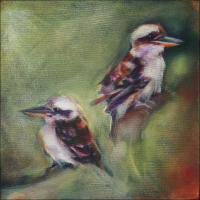 |
||
There is a work phase where, once details are added or changes made to one area, every other thing in the picture needs to be brought to the same level of quality: quality meaning style and feeling of the features. I don’t regret proceeding, but it does mean extra effort to solve all the new challenges, and usually while attempting to solve those new ones arise. Other professionals would say this is overworking, but it really depends on what your intentions are as an Artist, and what motivates the work. If risks are not taken sometimes, a painting may never be all that it could be. Phrases we tend to cling to like “less is more” are not written in stone; sometimes more is more…learning is a good thing!
In landscapes details are best left for the imagination, whereas painting animals, birds or other creatures, a purpose needs to be clearer. Is the intention to portray character through shape and silhouette? other traits? specific markings? Is it the main focus or only a part of the whole? Computer tools are also useful in playing with colors and other possibilities.
Sumac Bushes Chair finished
Tuesday, May 5th, 2009
Sumac Bushes, 47H x 22W x 16D inches refurbished Director’s Chair, acrylics on canvas.
Four cropped pieces of the 1999 painting that inspired this chair hang above it, updated and framed with red narrow plastic w/glass frames. The chair and small paintings are a set.
Fossils Chair, Homage to The Earth – finished
Wednesday, April 22nd, 2009
January 12th: While sanding the wood for the Sumac Bushes Chair during coffee breaks, I have started the Fossil Chair, paying homage to the fact that without trees, all life on Earth would not be so prolific, and might not exist at all. Fish and Trilobites are carved into the plaster on the front surface of the chair as well. in this series.
January 13th: Lower detail of Fossil Chair, carved plaster, acrylic paint inlay, sanded. In progress. Trilobites will have painted detail.
Jan. 14th and Jan. 24th updates, below: front details, work in progress on back/underside of the chair. After this stage, all details will continue to be refined with more carving and layers of acrylics. Haven’t done many details on the trilobites yet. The colors in the palm leaf still are too vibrant for a fossil, but are a perfect underlying color because it shows through when layers of blues and black are wiped away with a cloth.
 Fossils Chair, Homage to The Earth, started in January and finished today, except for refining the bark fossil patterns on the back/underside. 29 x 29 x 29 inches refurbished vintage chair, canvas strips, plaster, carved, acrylics, varnish, waxed.
Fossils Chair, Homage to The Earth, started in January and finished today, except for refining the bark fossil patterns on the back/underside. 29 x 29 x 29 inches refurbished vintage chair, canvas strips, plaster, carved, acrylics, varnish, waxed.
The back of this chair has authentic 225 – 345-million-year-old fossilized clam shells embedded around the circumference. Next, the Encyclopedia Britannica listing. The fossils were found in a mixture of playground pebbles in Dallas, TX.
The Cycad leaf fossil replica original was discovered in a Wyoming, USA river basin. Portrayed on the front of the chair is the fossil of a Cycad, the first of palm-like trees that grew about 50 million years ago in a Wyoming riverbed. The first trees on Earth were actually nothing more than woody stems standing in and absorbing nutrients from water. Patterns of fossilized Paleozoic Lepidodendron bark- leaf scars are painted on the underside of the chair. Lepidodendron were a primitive species of the very first trees on earth, reaching heights of 130 feet (40 m) tall around 400 million years ago. Can we even relate to those numbers? That’s what I love about fossils – holding one and contemplating Earth’s timeline is mind-blowing.
| Progress details: | |||||
 |
 |
 |
|||
 |
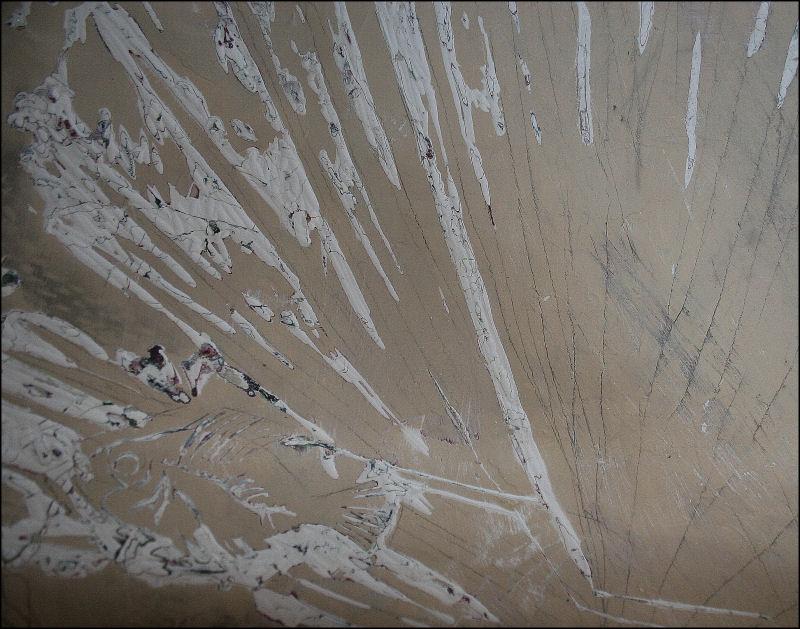 |
 |
|||
| Finished details: | |||||
 |
 |
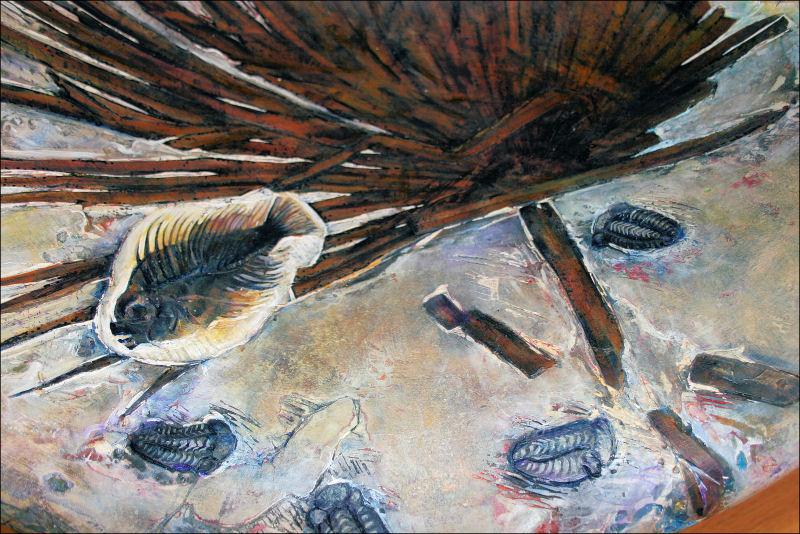 |
|||
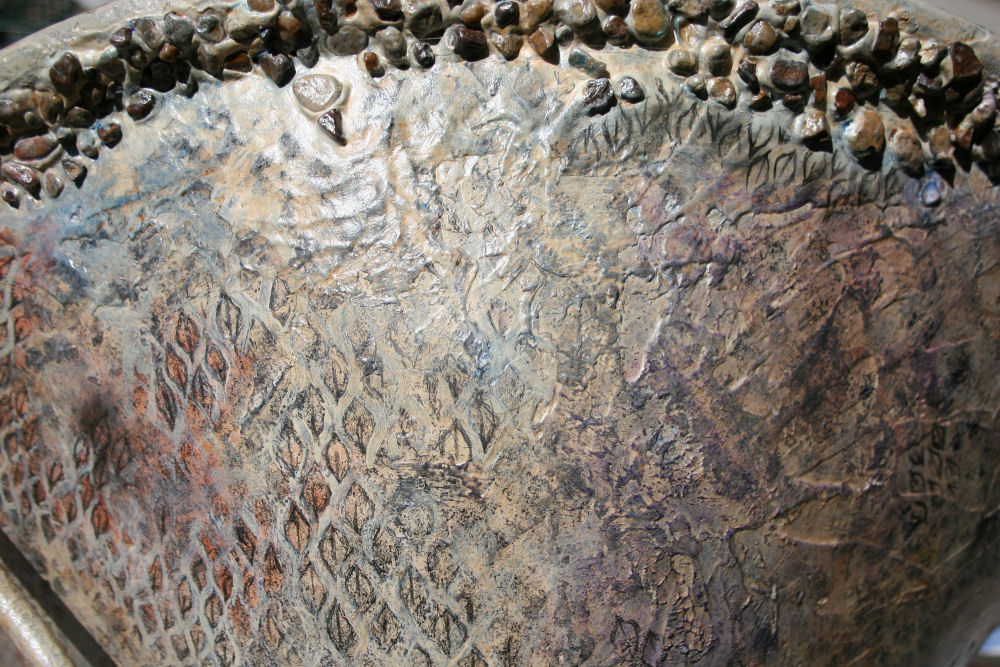 |
 |
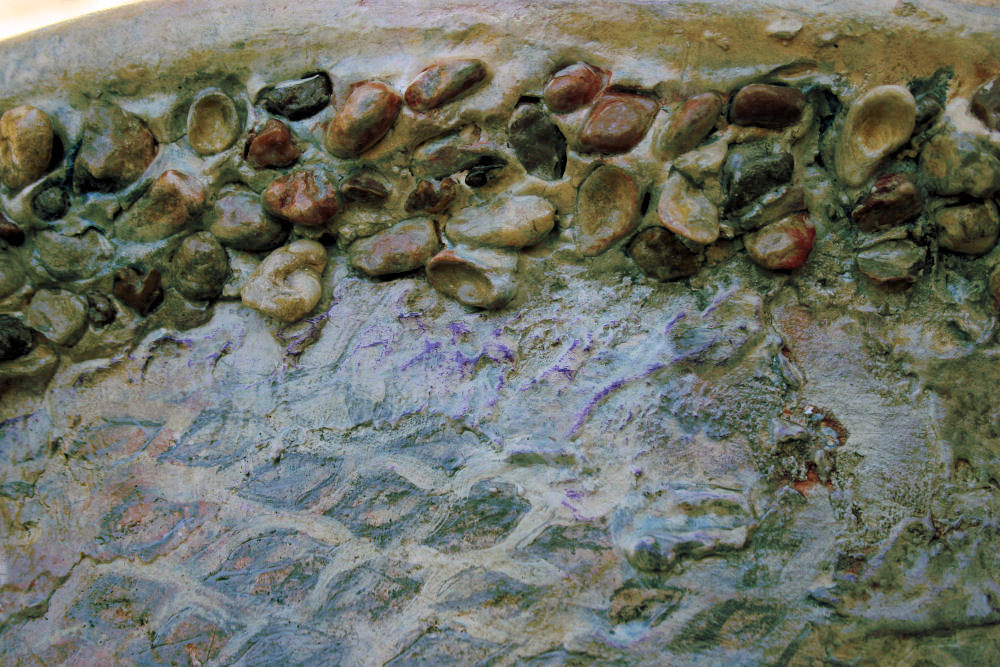 |
The perfect place for masking fluid
Monday, April 13th, 2009
 Flowering Shavingbrush Tree, April 11th above: details of 85H x 45W x 3D inches acrylics on canvas,wrapped sides painted, trim frame. Still in progress, but the rubberized mask was removed in order to see exactly what stage things are at before continuing. The painting overall still has a few areas to open up; very little work tomorrow should finish it. Shortly after starting the painting I turned it upside down and applied the masking fluid with a toothpick and let it drip. Gravity can be used as a tool!
Flowering Shavingbrush Tree, April 11th above: details of 85H x 45W x 3D inches acrylics on canvas,wrapped sides painted, trim frame. Still in progress, but the rubberized mask was removed in order to see exactly what stage things are at before continuing. The painting overall still has a few areas to open up; very little work tomorrow should finish it. Shortly after starting the painting I turned it upside down and applied the masking fluid with a toothpick and let it drip. Gravity can be used as a tool!
April 13th, Left: The top third will still leave as much of the primed canvas as possible; a gradation of unfinished space toward more finished at the bottom. I was hoping to leave it as seen here giving an airy illusion, but it does need to develop along with the rest of it…still not as much, but enough to show the main flower better. This means I’ll be once again dripping masking fluid on the piece upside down to preserve the interesting marks that occurred from the 1st application, and also create some new ones with any further work. For previous posts on earliest progress of this painting click here.
« Previous Entries Next Entries »



